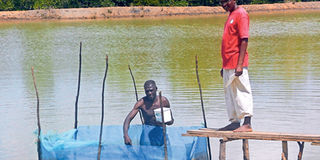For this group, prawns are new fish in ponds

Mtepeni Mangrove Conservation Community Group's assistant secretary, Kiti Nyale together with the coordinator, Fulgence Wanje Kalenga feed the prawns they keep in their project. Like fish which consists of low-fat, high quality protein, omega 3 fatty acids with vitamins, calcium, phosphorous, iron, iodine, magnesium and potassium, prawns also have high-quality protein and are low in calories with several vitamins and minerals. PHOTO | BOZO JENJE | NMG
What you need to know:
- The ponds are part of a mangrove forest conservation initiative by Mtepeni Community group, which uses them for prawn farming.
- The project got another boost in 2017, when FAO constructed for them another pond and offered them prawn juveniles, fish feeds, fertiliser and lime.
- Before harvesting, however, the group prepares well to prevent loss of prawns during the pond draining process.
- Kwetu Training Centre coordinator Brendan Muli says few community groups are vibrant in mariculture due to the challenges of getting the prawn juveniles.
At the Mtwapa Creek on the hilltop side of Mtepeni village, north of Mombasa, three large ponds sit in an open field next to a mangrove habitat.
The ponds are part of a mangrove forest conservation initiative by Mtepeni Community group, which uses them for prawn farming.
Fulgence Wanje Kalenga, the group’s coordinator, says they started as a mangrove conservation outfit but after attending training at Kwetu Training Centre in Mtwapa, they saw an opportunity in prawn farming.
Therefore, sometime in 2015, the group of 15 whose members were residing within a 5km radius of the mangrove area, started prawn farming following the help of Food Agricultural Organisation (FAO).
They constructed a pond with a holding capacity of 40,000 prawn juveniles.
However, they managed to collect and stock the pond with about 35,000 wild prawn juveniles that were caught between December, 2015 to February, 2016 from the mangrove breeding grounds in the Indian Ocean.
But as fate would have it, an abnormal tide occurred and destroyed part of the pond wall leading to a loss of some of the juveniles.
“Out of the 35,000 prawns, we only harvested 112 white prawns, 10 tiger prawns, 73 cocktail prawns, 77 milk fish, 20 fry fish and 29 queen fish,” says Kalenge.
The project got another boost in 2017, when FAO constructed for them another pond and offered them prawn juveniles, fish feeds, fertiliser and lime.
At harvesting, which is done at four months, they further received 10 buckets, two cooler boxes, three harvesting nets of 50 meters each, four life jackets, and pond fencing nets with threads of about 1,020 metres. “FAO also provided us with training on pond management, preparation and predator management to ensure the mariculture project succeeded,” he says, adding their activities have since picked up.
Their buyers include traders, households and hotels, which are informed before the harvest day to buy the prawns on site if they can.
A kilo of prawns goes for between Sh300 and Sh1,200 depending on the species.
Before harvesting, however, the group prepares well to prevent loss of prawns during the pond draining process.
PREDATORS EAT STOCKED JUVENILES
“First, we set a perimeter net to cover the outlet pipes to trap the mature prawns. After harvesting, the prawns are washed on top of an improvised bamboo table, then they are sorted based on weight and stored in coolers to prevent post-harvest losses.”
To prepare the ponds for juveniles stocking, Kalenga says first a soil sample is collected to determine the pH and the content of the organic matter.
“In case it is below the requirement, corrective measures are undertaken to increase the fertility of the ponds. Then, excavation is done to attain the specific depth and wall heights depending on the low and high water tides in the ocean.”
Then the ponds are dried and to reduce soil acidity during drying stage, liming is done using magnesium and calcium.
Lime assists in killing the micro-organisms that are harmful to the fries.
Afterwards, the juveniles are introduced after the algae germinates at the base of the pond and water is exchanged at every tide, food supplements provided and predators are daily monitored.
Predators are dangerous since they eat the stocked juveniles.
“They include wading birds that prey on the growing prawns in shallow waters of the ponds and the crabs burrow into the dykes making ponds leak. Reptiles such as water snakes, molluscs and frogs are also a threat so is poor quality water management,” he adds.
Kwetu Training Centre coordinator Brendan Muli says few community groups are vibrant in mariculture due to the challenges of getting the prawn juveniles.
Muli, who is also a mariculture and mangrove conservation specialist, says it is difficult to get enough juveniles to fill the pond since the prawns breed seasonal.
“Prawns are too sensitive to keep and most cases community are discouraged as they are associated with high mortality.”
With lack of established prawn feed suppliers, the production levels are limited, according to him, highlighting the challenges the industry faces.
“Selecting the ecosystem to establish the ponds requires expertise that includes better water quality management,” Muli says, but adds that there is potential in the business if various stakeholders from the government and private sector are involved.
Like fish which consists of low-fat, high quality protein, omega 3 fatty acids with vitamins, calcium, phosphorous, iron, iodine, magnesium and potassium, prawns also have high — quality protein and are low in calories with several vitamins and minerals.





